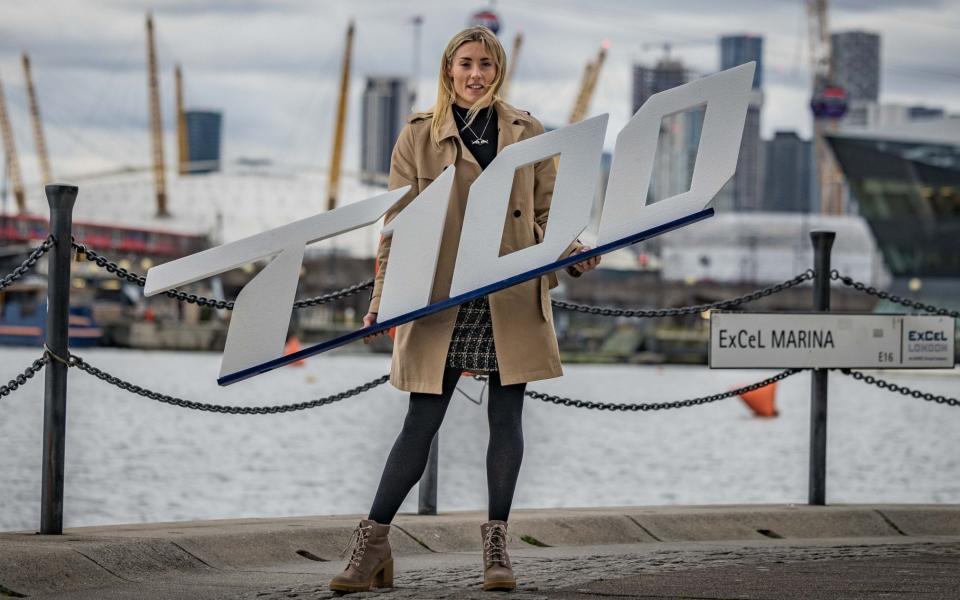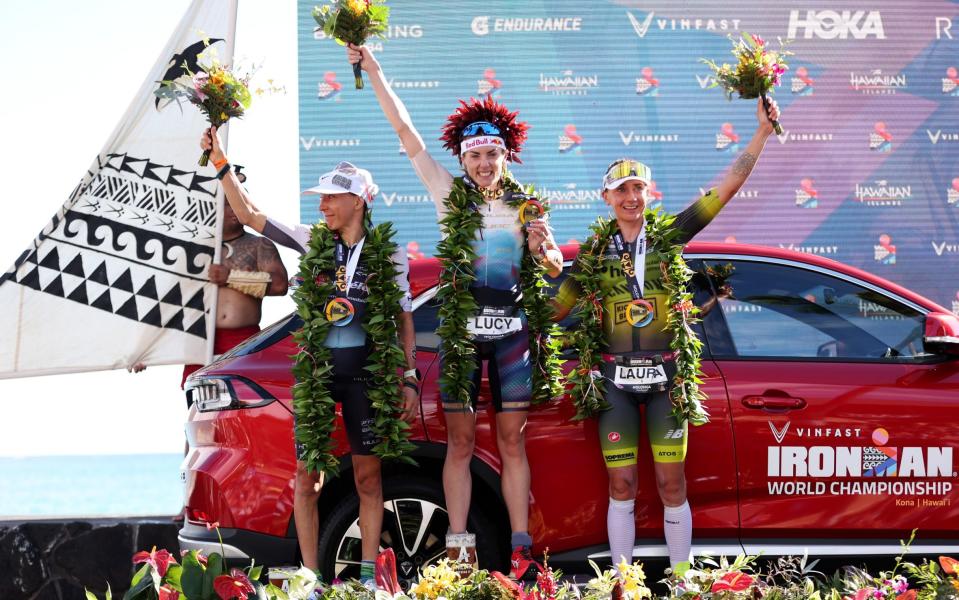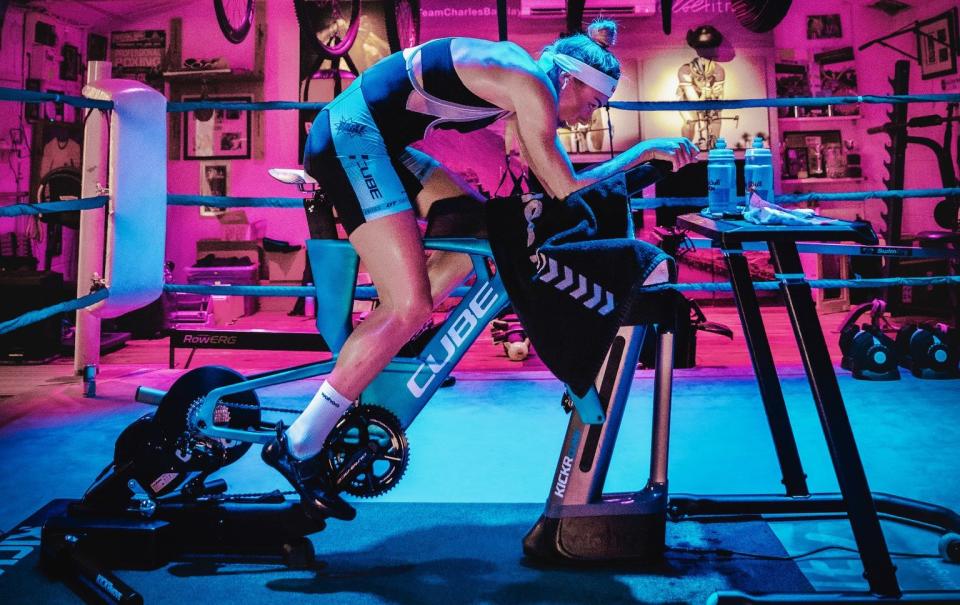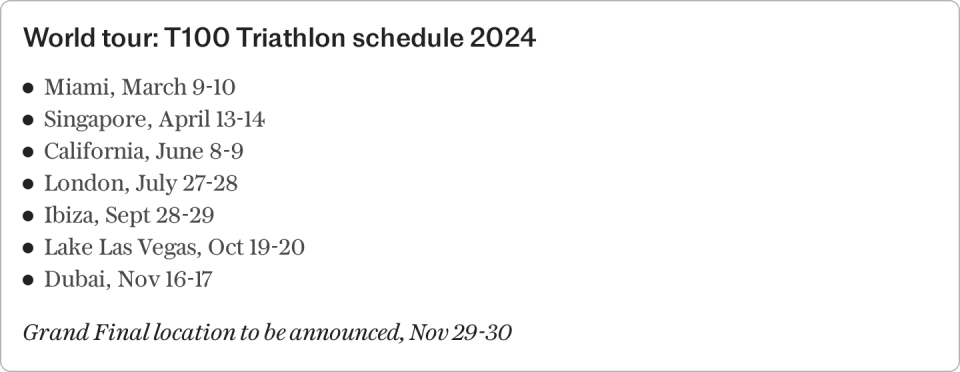Lucy Charles-Barclay on 100km triathlons, broken bones and her ‘pain cave’

Lucy Charles-Barclay knows a thing or two about pushing through the pain barrier. The British triathlete ran a full marathon on a blown Achilles en route to becoming the Ironman world champion last October, in what was a crowning moment of her career.
The 30-year-old had finished as a runner-up four consecutive times at the event in Hawaii, where athletes face a gruelling test of body and mind in extreme, humid conditions.
Charles-Barclay did not only win the event, but set a world record, completing the 2.4-mile swim, 112-mile bike ride and marathon in 8hr 24min 31sec. Now, she is ready to embrace her next big challenge.
Rather than defending her title, Charles-Barclay is throwing all her energy into a new event as triathlon attempts to cross into the mainstream.

Launching in Miami next month, the T100 Triathlon World Tour will feature 20 male and female athletes competing over 100km distances (2km swim, 80km bike ride and 18km run) across eight cities, including London in late July.
The rebranded series was launched amid much fanfare this month in London. Chris Kermode, the chairman of the Professional Triathlon Organisation who masterminded tennis’s hugely successful ATP World Finals, boldly predicted that triathlon could become one of the biggest sport entertainment products in the next few years.
It is a sentiment shared by Charles-Barclay. With more than half a million followers across her Instagram and YouTube channels, she is one of triathlon’s most marketable stars.
“If the broadcast and storytelling is done right, there’s no reason why it can’t boom in the mainstream,” says Charles-Barclay, who has decided not to pursue a Paris Olympics place to focus on the T100 series. “I’d love to see it be one of the Netflix series, like in tennis, golf or rugby. My sister does all my YouTube content, so I’m used to having a camera follow me around. That would be amazing.”

A fly-on-the-wall documentary charting the superhuman limits that Charles-Barclay pushes her body to would certainly make compelling viewing. The former long-distance swimmer is the proud owner of a “pain cave” near her home in east London, where she can simulate the harsh environments of warm-weather training thanks to altitude generators.
“It’s at my in-laws. My father-in-law used to be a professional boxer, so he built this outhouse. We then started transforming what was an old-school gym into our pain cave, getting new treadmills, upgrading equipment.
“We have an endless pool in there which is like a swimming-pool treadmill, so you can swim on the spot against a current. We can do swim-bike-run in this one space, but also weightlifting and strength and conditioning stuff. Essentially, what was a spit-and-sawdust boxing gym has become a high-performance triathlon gym.”
The pain cave forms a small part of Charles-Barclay’s relentless training. The day after our chat, she is off to Lanzarote, where she will fine-tune preparations for the opening leg of the T100 series.

Despite three different triathlon world titles in as many years, Charles-Barclay has never won a 100km race. She hopes to bottle the resilience built up over two injury-hit seasons to try to win the inaugural event, having overcome a hip fracture and a broken foot.
“The foot break was a freak accident,” she says. “I was doing a half Ironman and felt immense pain. In high-level sport, you’re on a knife edge between being world-beating and being broken. That’s the really difficult balance. One of the things that makes me susceptible to bone injuries is my background in swimming. Growing up, I only did swimming, which is a really low-impact sport. Coming into triathlon, where running is high-impact, I don’t think my bones were necessarily equipped, so they’ve had to adapt.”
Sharing the context around such injuries, Charles-Barclay insists, is important in triathlon, a sport where participants are at risk of RED-S – a syndrome endurance athletes can develop when they are under-fuelled. Those developing it usually believe a specific physique or weight will improve performance, but an energy deficit can severely impact the body.
In women, low bone density because of depleted oestrogen levels can lead to amenorrhea – the loss of periods – and make them more susceptible to fractures.
Charles-Barclay says awareness of the condition is growing in her sport. When fellow Briton Emma Pallant-Browne, who previously suffered from it, was pictured bleeding through her bodysuit while on her period last year, she used it to warn of the danger of not having a regular cycle.
“It’s definitely more educated about,” Charles-Barclay says of RED-S. “As athletes, we have a responsibility to share that as well. But one of the great things of triathlon is women and men of all shapes and sizes doing well at it. You don’t need to be a certain size to do this and it’s really important to convey that.”
Charles-Barclay has grown used to seeing comments about her body online – many speculating about the cause of her injuries were quick to focus on her lean physique. She credits her close entourage, including her full-time coach and husband Reece, for helping her through. “There are a lot of strong women in this sport – and there’s always been equal pay, equal coverage, and some of the highest-followed athletes are female,” she says. “The women are doing a great job of driving that.”
For now, her focus will be on the T100, which presents an entirely new challenge. “This will be way out of my comfort zone. From the moment the gun goes, it hurts. In this sort of racing, you do see athletes collapsing on the line.”

 Yahoo Sport
Yahoo Sport 





































